Voriconazole (injection)
Editor-In-Chief: C. Michael Gibson, M.S., M.D. [1]; Associate Editor(s)-in-Chief: Alberto Plate [2]
Disclaimer
WikiDoc MAKES NO GUARANTEE OF VALIDITY. WikiDoc is not a professional health care provider, nor is it a suitable replacement for a licensed healthcare provider. WikiDoc is intended to be an educational tool, not a tool for any form of healthcare delivery. The educational content on WikiDoc drug pages is based upon the FDA package insert, National Library of Medicine content and practice guidelines / consensus statements. WikiDoc does not promote the administration of any medication or device that is not consistent with its labeling. Please read our full disclaimer here.
Overview
Voriconazole (injection) is an antifungal triazole that is FDA approved for the treatment of invasive aspergillosis, candidemia in non-neutropenic patients, esophageal candidiasis, serious fungal infections caused by Scedosporium apiospermum and Fusarium spp. including Fusarium solani, in patients intolerant of, or refractory to, other therapy. Common adverse reactions include visual disturbances, fever, nausea, rash, vomiting, chills, headache, abnormal liver function test, tachycardia, and hallucinations.
Adult Indications and Dosage
FDA-Labeled Indications and Dosage (Adult)
Instructions for Use in All Patients
- Voriconazole I.V. for Injection requires reconstitution to 10 mg/mL and subsequent dilution to 5 mg/mL or less prior to administration as an infusion, at a maximum rate of 3 mg/kg per hour over 1 to 2 hours.
- Do not administer as an IV bolus injection.
Use of Voriconazole I.V. With Other Parenteral Drug Products
Blood products and concentrated electrolytes
- Voriconazole I.V. must not be infused concomitantly with any blood product or short-term infusion of concentrated electrolytes, even if the two infusions are running in separate intravenous lines (or cannulas). Electrolyte disturbances such as hypokalemia, hypomagnesemia and hypocalcemia should be corrected prior to initiation of Voriconazole therapy.
Intravenous Solutions Containing (Non-Concentrated) Electrolytes
- Voriconazole I.V. can be infused at the same time as other intravenous solutions containing (non-concentrated) electrolytes, but must be infused through a separate line.
Total Parenteral Nutrition (TPN)
- Voriconazole I.V. can be infused at the same time as total parenteral nutrition, but must be infused in a separate line. If infused through a multiple-lumen catheter, TPN needs to be administered using a different port from the one used for Voriconazole I.V.
Recommended Dosing in Adults
Invasive Aspergillosis and Serious Fungal Infections due to Fusarium spp. and Scedosporium apiospermum
- See TABLE 1. Therapy must be initiated with the specified loading dose regimen of intravenous Voriconazole on Day 1 followed by the recommended maintenance dose regimen. Intravenous treatment should be continued for at least 7 days. Once the patient has clinically improved and can tolerate medication given by mouth, the oral tablet form or oral suspension form of Voriconazole may be utilized. The recommended oral maintenance dose of 200 mg achieves a voriconazole exposure similar to 3 mg/kg IV; a 300 mg oral dose achieves an exposure similar to 4 mg/kg IV. Switching between the intravenous and oral formulations is appropriate because of the high bioavailability of the oral formulation in adults.
Candidemia in Non-Neutropenic Patients and other Deep Tissue Candida Infections
- See TABLE 1. Patients should be treated for at least 14 days following resolution of symptoms or following last positive culture, whichever is longer.
Esophageal Candidiasis
- See TABLE 1. Patients should be treated for a minimum of 14 days and for at least 7 days following resolution of symptoms.
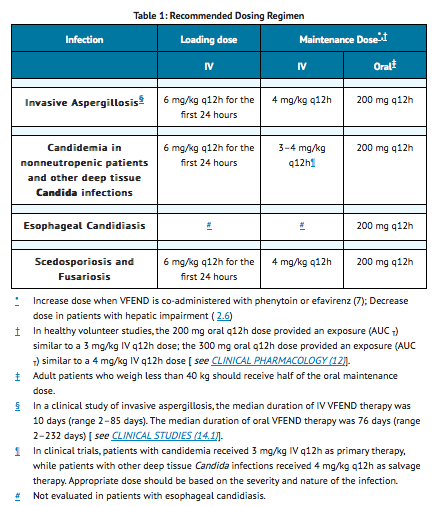
Dosage Adjustment
- If patient response is inadequate, the oral maintenance dose may be increased from 200 mg every 12 hours (similar to 3 mg/kg IV q12h) to 300 mg every 12 hours (similar to 4 mg/kg IV q12h). For adult patients weighing less than 40 kg, the oral maintenance dose may be increased from 100 mg every 12 hours to 150 mg every 12 hours. If patient is unable to tolerate 300 mg orally every 12 hours, reduce the oral maintenance dose by 50 mg steps to a minimum of 200 mg every 12 hours (or to 100 mg every 12 hours for adult patients weighing less than 40 kg).
- If patient is unable to tolerate 4 mg/kg IV q12h, reduce the intravenous maintenance dose to 3 mg/kg q12h. The maintenance dose of voriconazole should be increased when co-administered with phenytoin or efavirenz. The maintenance dose of voriconazole should be reduced in patients with mild to moderate hepatic impairment, Child-Pugh Class A and B. There are no PK data to allow for dosage adjustment recommendations in patients with severe hepatic impairment (Child-Pugh Class C). Duration of therapy should be based on the severity of the patient's underlying disease, recovery from immunosuppression, and clinical response.
Off-Label Use and Dosage (Adult)
Guideline-Supported Use
There is limited information regarding Off-Label Guideline-Supported Use of Voriconazole in adult patients.
Non–Guideline-Supported Use
There is limited information regarding Off-Label Non–Guideline-Supported Use of Voriconazole in adult patients.
Pediatric Indications and Dosage
FDA-Labeled Indications and Dosage (Pediatric)
There is limited information regarding Voriconazole (injection) FDA-Labeled Indications and Dosage (Pediatric) in the drug label.
Off-Label Use and Dosage (Pediatric)
Guideline-Supported Use
There is limited information regarding Off-Label Guideline-Supported Use of Voriconazole in pediatric patients.
Non–Guideline-Supported Use
There is limited information regarding Off-Label Non–Guideline-Supported Use of Voriconazole in pediatric patients.
Contraindications
- Voriconazole is contraindicated in patients with known hypersensitivity to voriconazole or its excipients. There is no information regarding cross-sensitivity between Voriconazole (voriconazole) and other azole antifungal agents. Caution should be used when prescribing Voriconazole to patients with hypersensitivity to other azoles.
- Coadministration of terfenadine, astemizole, cisapride, pimozide or quinidine with Voriconazole is contraindicated because increased plasma concentrations of these drugs can lead to QT prolongation and rare occurrences of torsade de pointes.
- Coadministration of Voriconazole with sirolimus is contraindicated because Voriconazole significantly increases sirolimus concentrations
- Coadministration of Voriconazole with rifampin, carbamazepine and long-acting barbiturates is contraindicated because these drugs are likely to decrease plasma voriconazole concentrations significantly.
- Coadministration of standard doses of voriconazole with efavirenz doses of 400 mg q24h or higher is contraindicated, because efavirenz significantly decreases plasma voriconazole concentrations in healthy subjects at these doses.
- Voriconazole also significantly increases efavirenz plasma concentrations.
- Coadministration of Voriconazole with high-dose ritonavir (400 mg q12h) is contraindicated because ritonavir (400 mg q12h) significantly decreases plasma voriconazole concentrations. Coadministration of voriconazole and low-dose ritonavir (100 mg q12h) should be avoided, unless an assessment of the benefit/risk to the patient justifies the use of voriconazole.
- Coadministration of Voriconazole with rifabutin is contraindicated since Voriconazole significantly increases rifabutin plasma concentrations and rifabutin also significantly decreases voriconazole plasma concentrations.
- Coadministration of Voriconazole with ergot alkaloids (ergotamine and dihydroergotamine) is contraindicated because Voriconazole may increase the plasma concentration of ergot alkaloids, which may lead to ergotism.
- Coadministration of Voriconazole with St. John's Wort is contraindicated because this herbal supplement may decrease voriconazole plasma concentration.
Warnings
Hepatic Toxicity
- In clinical trials, there have been uncommon cases of serious hepatic reactions during treatment with Voriconazole (including clinical hepatitis, cholestasis and fulminant hepatic failure, including fatalities). Instances of hepatic reactions were noted to occur primarily in patients with serious underlying medical conditions (predominantly hematological malignancy). Hepatic reactions, including hepatitis and jaundice, have occurred among patients with no other identifiable risk factors. Liver dysfunction has usually been reversible on discontinuation of therapy.
- Monitoring of hepatic function Liver function tests should be evaluated at the start of and during the course of Voriconazole therapy. Patients who develop abnormal liver function tests during Voriconazole therapy should be monitored for the development of more severe hepatic injury. Patient management should include laboratory evaluation of hepatic function (particularly liver function tests and bilirubin). Discontinuation of Voriconazole must be considered if clinical signs and symptoms consistent with liver disease develop that may be attributable to Voriconazole.
Visual Disturbances
- The effect of Voriconazole on visual function is not known if treatment continues beyond 28 days. There have been post-marketing reports of prolonged visual adverse events, including optic neuritis and papilledema. If treatment continues beyond 28 days, visual function including visual acuity, visual field and color perception should be monitored.
Embryo-Fetal Toxicity
- Voriconazole can cause fetal harm when administered to a pregnant woman.
- In animals, voriconazole administration was associated with teratogenicity, embryotoxicity, increased gestational length, dystocia and embryomortality. If this drug is used during pregnancy, or if the patient becomes pregnant while taking this drug, the patient should be informed of the potential hazard to the fetus.
Arrhythmias and QT Prolongation
- Some azoles, including voriconazole, have been associated with prolongation of the QT interval on the electrocardiogram. During clinical development and post-marketing surveillance, there have been rare cases of arrhythmias, (including ventricular arrhythmias such as torsade de pointes), cardiac arrests and sudden deaths in patients taking voriconazole. These cases usually involved seriously ill patients with multiple confounding risk factors, such as history of cardiotoxic chemotherapy, cardiomyopathy, hypokalemia and concomitant medications that may have been contributory. Voriconazole should be administered with caution to patients with these potentially proarrhythmic conditions. Rigorous attempts to correct potassium, magnesium and calcium should be made before starting voriconazole.
Infusion Related Reactions
- During infusion of the intravenous formulation of voriconazole in healthy subjects, anaphylactoid-type reactions, including flushing, fever, sweating, tachycardia, chest tightness, dyspnea, faintness, nausea, pruritus and rash, have occurred uncommonly. Symptoms appeared immediately upon initiating the infusion. Consideration should be given to stopping the infusion should these reactions occur.
Laboratory Tests
- Electrolyte disturbances such as hypokalemia, hypomagnesemia and hypocalcemia should be corrected prior to initiation of Voriconazole therapy. Patient management should include laboratory evaluation of renal (particularly serum creatinine) and hepatic function (particularly liver function tests and bilirubin).
Patients With Hepatic Impairment
- It is recommended that the standard loading dose regimens be used but that the maintenance dose be halved in patients with mild to moderate hepatic cirrhosis (Child-Pugh Class A and B) receiving Voriconazole.
- Voriconazole has not been studied in patients with severe cirrhosis (Child-Pugh Class C). Voriconazole has been associated with elevations in liver function tests and clinical signs of liver damage, such as jaundice, and should only be used in patients with severe hepatic insufficiency if the benefit outweighs the potential risk. Patients with hepatic insufficiency must be carefully monitored for drug toxicity.
Patients With Renal Impairment
- In patients with moderate to severe renal dysfunction (creatinine clearance <50 mL/min), accumulation of the intravenous vehicle, SBECD, occurs. Oral voriconazole should be administered to these patients, unless an assessment of the benefit/risk to the patient justifies the use of intravenous voriconazole. Serum creatinine levels should be closely monitored in these patients, and if increases occur, consideration should be given to changing to oral voriconazole therapy.
Monitoring of Renal Function
- Acute renal failure has been observed in patients undergoing treatment with Voriconazole. Patients being treated with voriconazole are likely to be treated concomitantly with nephrotoxic medications and have concurrent conditions that may result in decreased renal function. Patients should be monitored for the development of abnormal renal function. This should include laboratory evaluation, particularly serum creatinine.
Monitoring of Pancreatic Function
- Patients with risk factors for acute pancreatitis (e.g., recent chemotherapy, hematopoietic stem cell transplantation [HSCT]) should be monitored for the development of pancreatitis during Voriconazole treatment.
Dermatological Reactions
- Serious exfoliative cutaneous reactions, such as Stevens-Johnson syndrome, have been reported during treatment with Voriconazole. If a patient develops an exfoliative cutaneous reaction, Voriconazole should be discontinued. In addition Voriconazole has been associated with photosensitivity skin reaction. Patients should avoid intense or prolonged exposure to direct sunlight during Voriconazole treatment. In patients with photosensitivity skin reactions squamous cell carcinoma of the skin and melanoma have been reported during long-term therapy. If a patient develops a skin lesion consistent with squamous cell carcinoma or melanoma, Voriconazole should be discontinued.
Skeletal Adverse Events
- Fluorosis and periostitis have been reported during long-term voriconazole therapy. If a patient develops skeletal pain and radiologic findings compatible with fluorosis or periostitis, voriconazole should be discontinued.
Adverse Reactions
Clinical Trials Experience
- The data described in Table 3 reflect exposure to voriconazole in 1655 patients in the therapeutic studies. This represents a heterogeneous population, including immunocompromised patients, e.g., patients with hematological malignancy or HIV and non-neutropenic patients. This subgroup does not include healthy subjects and patients treated in the compassionate use and non-therapeutic studies. This patient population was 62% male, had a mean age of 46 years (range 11–90, including 51 patients aged 12–18 years), and was 78% White and 10% Black. Five hundred sixty one patients had a duration of voriconazole therapy of greater than 12 weeks, with 136 patients receiving voriconazole for over six months. Table 3 includes all adverse events which were reported at an incidence of ≥2% during voriconazole therapy in the all therapeutic studies population, studies 307/602 and 608 combined, or study 305, as well as events of concern which occurred at an incidence of <2%.
- In study 307/602, 381 patients (196 on voriconazole, 185 on amphotericin B) were treated to compare voriconazole to amphotericin B followed by other licensed antifungal therapy in the primary treatment of patients with acute invasive aspergillosis. The rate of discontinuation from voriconazole study medication due to adverse events was 21.4% (42/196 patients). In study 608, 403 patients with candidemia were treated to compare voriconazole (272 patients) to the regimen of amphotericin B followed by fluconazole (131 patients). The rate of discontinuation from voriconazole study medication due to adverse events was 19.5% out of 272 patients. Study 305 evaluated the effects of oral voriconazole (200 patients) and oral fluconazole (191 patients) in the treatment of esophageal candidiasis. The rate of discontinuation from voriconazole study medication in Study 305 due to adverse events was 7% (14/200 patients). Laboratory test abnormalities for these studies are discussed under Clinical Laboratory Values below:
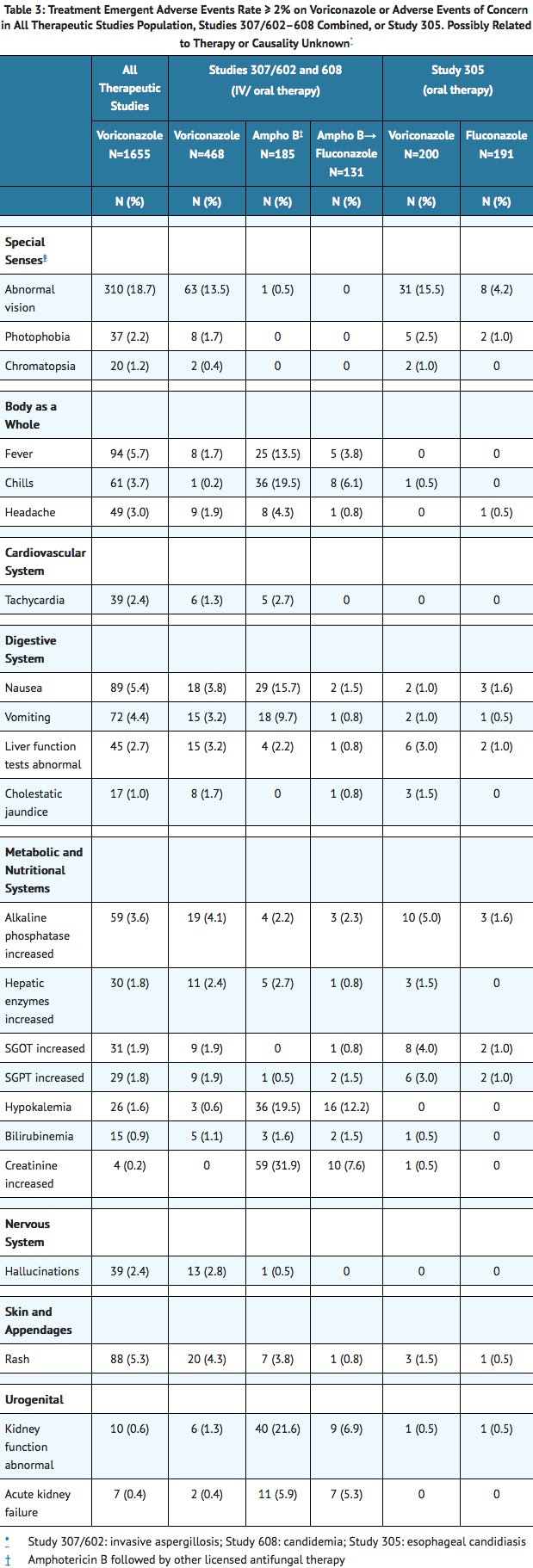
Visual Disturbances
- Voriconazole treatment-related visual disturbances are common. In therapeutic trials, approximately 21% of patients experienced abnormal vision, color vision change and/or photophobia. Visual disturbances may be associated with higher plasma concentrations and/or doses. There have been post-marketing reports of prolonged visual adverse events, including optic neuritis and papilledema. The mechanism of action of the visual disturbance is unknown, although the site of action is most likely to be within the retina. In a study in healthy subjects investigating the effect of 28-day treatment with voriconazole on retinal function, voriconazole caused a decrease in the electroretinogram (ERG) waveform amplitude, a decrease in the visual field, and an alteration in color perception. The ERG measures electrical currents in the retina. The effects were noted early in administration of voriconazole and continued through the course of study drug dosing. Fourteen days after end of dosing, ERG, visual fields and color perception returned to normal.
Dermatological Reactions
- Dermatological reactions were common in the patients treated with voriconazole. The mechanism underlying these dermatologic adverse events remains unknown.
- Serious cutaneous reactions, including Stevens-Johnson syndrome, toxic epidermal necrolysis and erythema multiforme have been reported during treatment with Voriconazole. If a patient develops an exfoliative cutaneous reaction, Voriconazole should be discontinued.
- In addition, Voriconazole has been associated with photosensitivity skin reactions. Patients should avoid strong, direct sunlight during Voriconazole therapy. In patients with photosensitivity skin reactions, squamous cell carcinoma of the skin and melanoma have been reported during long-term therapy. If a patient develops a skin lesion consistent with squamous cell carcinoma or melanoma, Voriconazole should be discontinued.
Less Common Adverse Events
- The following adverse events occurred in <2% of all voriconazole-treated patients in all therapeutic studies (N=1655). This listing includes events where a causal relationship to voriconazole cannot be ruled out or those which may help the physician in managing the risks to the patients. The list does not include events included in Table 5 above and does not include every event reported in the voriconazole clinical program.
Body as a Whole
- Abdominal pain
- Abdomen enlarged
- Allergic reaction
- Anaphylactoid reaction
- Ascites
- Asthenia
- Back pain
- Chest pain
- Cellulitis
- Edema
- Face edema
- Flank pain
- Flu syndrome
- Graft versus host reaction
- Granuloma
- Infection
- Bacterial infection
- Fungal infection
- Injection site pain
- Injection site infection/inflammation
- Mucous membrane disorder
- Multi-organ failure
- Pain
- Pelvic pain
- Peritonitis
- Sepsis
- Substernal chest pain
Cardiovascular
- Atrial arrhythmia
- Atrial fibrillation
- AV block complete
- Bigeminy
- Bradycardia
- Bundle branch block
- Cardiomegaly
- Cardiomyopathy
- Cerebral hemorrhage
- Cerebral ischemia
- Cerebrovascular accident
- Congestive heart failure
- Deep thrombophlebitis
- Endocarditis
- Extrasystoles
- Heart arrest
- Hypertension
- Hypotension
- Myocardial infarction
- Nodal arrhythmia
- Palpitation
- Phlebitis
- Postural hypotension
- Pulmonary embolus
- QT prolongation
- Supraventricular extrasystoles
- Supraventricular tachycardia
- Syncope
- Thrombophlebitis
- Vasodilatation
- Ventricular arrhythmia
- Ventricular fibrillation
- Ventricular tachycardia (including torsade de pointes)
Digestive
- Anorexia
- Cheilitis
- Cholecystitis
- Cholelithiasis
- Constipation
- Diarrhea
- Duodenal ulcer perforation
- Duodenitis
- Dyspepsia
- Dysphagia
- Dry mouth
- Esophageal ulcer
- Esophagitis
- Flatulence
- Gastroenteritis
- Gastrointestinal hemorrhage
- GGT/LDH elevation
- Gingivitis
- Glossitis
- Gum hemorrhage
- Gum hyperplasia
- Hematemesis
- Hepatic coma
- Hepatic failure
- Hepatitis
- Intestinal perforation
- Intestinal ulcer
- Jaundice
- Enlarged liver
- Melena
- Mouth ulceration
- Pancreatitis
- Parotid gland enlargement
- Periodontitis
- Proctitis
- Pseudomembranous colitis
- Rectal disorder
- Rectal Hemorrhage
- Stomach ulcer
- Stomatitis
- Tongue edema
Endocrine
Hemic and Lymphatic
- Agranulocytosis
- Anemia (macrocytic, megaloblastic, microcytic, normocytic)
- Aplastic anemia
- Hemolytic anemia
- Bleeding time increased
- Cyanosis
- DIC
- Ecchymosis
- Eosinophilia
- Hypervolemia
- Leukopenia
- Lymphadenopathy
- Lymphangitis
- Marrow depression
- Pancytopenia
- Petechia
- Purpura
- Enlarged spleen
- Thrombocytopenia
- Thrombotic thrombocytopenic purpura
Metabolic and Nutritional
- Albuminuria
- BUN increased
- Creatine phosphokinase increased
- Edema
- Glucose tolerance decreased
- Hypercalcemia
- Hypercholesteremia
- Hyperglycemia
- Hyperkalemia
- Hypermagnesemia
- Hypernatremia
- Hyperuricemia
- Hypocalcemia
- Hypoglycemia
- Hypomagnesemia
- Hyponatremia
- Hypophosphatemia
- Peripheral edema
- Uremia
Musculoskeletal
- Arthralgia
- Arthritis
- Bone necrosis
- Bone pain
- Leg cramp
- Myalgia
- Myasthenia
- Myopathy
- Osteomalacia
- Osteoporosis
Nervous System
- Abnormal dreams
- Acute brain syndrome
- Agitation
- Akathisia
- Amnesia
- Anxiety
- Ataxia
- Brain edema
- Coma
- Confusion
- Convulsion
- Delirium
- Dementia
- Depersonalization
- Depression
- Diplopia
- Dizziness
- Encephalitis
- Encephalopathy
- Euphoria
- Extrapyramidal Syndrome
- Grand mal convulsion
- Guillain-Barré syndrome
- Hypertonia
- Hypesthesia
- Insomnia
- Intracranial hypertension
- Libido decreased
- Neuralgia
- Neuropathy
- Nystagmus
- Oculogyric crisis
- paresthesia
- Psychosis
- Somnolence
- Suicidal ideation
- Tremor
- Vertigo
Respiratory System
- Cough increased
- Dyspnea
- Epistaxis
- Hemoptysis
- Hypoxia
- Lung edema
- Pharyngitis
- Pleural effusion
- Pneumonia
- Respiratory disorder
- Respiratory distress syndrome
- Respiratory tract infection
- Rhinitis
- Sinusitis
- Voice alteration
Skin and Appendages
- Alopecia
- Angioedema
- Contact dermatitis
- Discoid lupus erythematosis
- Eczema
- Erythema multiforme
- Exfoliative dermatitis
- Fixed drug eruption
- Furunculosis
- Herpes simplex
- Maculopapular rash
- Melanoma
- Melanosis
- Photosensitivity skin reaction
- Pruritus
- Pseudoporphyria
- Psoriasis
- Skin discoloration
- Skin disorder
- Skin dry
- Stevens-Johnson syndrome
- Squamous cell carcinoma
- Sweating
- Toxic epidermal necrolysis
- Urticaria
Special Senses
- Abnormality of accommodation
- blepharitis
- Color blindness
- Conjunctivitis
- Corneal opacity
- Deafness
- Ear pain
- Eye pain
- Eye hemorrhage
- Dry eyes
- Hypoacusis
- Keratitis
- Keratoconjunctivitis
- Mydriasis
- Night blindness
- Optic atrophy
- Optic neuritis
- Otitis externa
- Papilledema
- Retinal hemorrhage
- Retinitis
- Scleritis
- Taste loss
- Taste perversion
- Tinnitus
- Uveitis
- Visual field defect
Urogenital
- Anuria
- Blighted ovum
- Creatinine clearance decreased
- Dysmenorrhea
- Dysuria
- Epididymitis
- Glycosuria
- Hemorrhagic cystitis
- Hematuria
- Hydronephrosis
- Impotence
- Kidney pain
- Kidney tubular necrosis
- Metrorrhagia
- Nephritis
- Nephrosis
- Oliguria
- Scrotal edema
- Urinary incontinence
- Urinary retention
- Urinary tract infection
- uterine hemorrhage
- Vaginal hemorrhage
Postmarketing Experience
There is limited information regarding Voriconazole (injection) Postmarketing Experience in the drug label.
Drug Interactions

Use in Specific Populations
Pregnancy
- Voriconazole can cause fetal harm when administered to a pregnant woman and should not be taken in pregnancy except in patients where the benefit to the mother clearly outweighs the potential risk to the fetus. There are no adequate and well-controlled studies in pregnant women.
- If this drug is used during pregnancy, or if the patient becomes pregnant while taking this drug, the patients should be informed of the potential hazard to the fetus
Animal Data
- Voriconazole was teratogenic in rats (cleft palates, hydronephrosis/hydroureter) from 10 mg/kg (0.3 times the recommended maintenance dose (RMD) on a mg/m2 basis) and embryotoxic in rabbits at 100 mg/kg (6 times the RMD). Other effects in rats included reduced ossification of sacral and caudal vertebrae, skull, pubic and hyoid bone, supernumerary ribs, anomalies of the sternebrae and dilatation of the ureter/renal pelvis. Plasma estradiol in pregnant rats was reduced at all dose levels. Voriconazole treatment in rats produced increased gestational length and dystocia, which were associated with increased perinatal pup mortality at the 10 mg/kg dose. The effects seen in rabbits were an increased embryomortality, reduced fetal weight and increased incidences of skeletal variations, cervical ribs and extrasternebral ossification sites.
Pregnancy Category (AUS):
There is no Australian Drug Evaluation Committee (ADEC) guidance on usage of Voriconazole (injection) in women who are pregnant.
Labor and Delivery
There is no FDA guidance on use of Voriconazole (injection) during labor and delivery.
Nursing Mothers
- It is not known whether voriconazole is excreted in human milk. Because many drugs are excreted in human milk and because of the potential for serious adverse reactions in nursing infants from Voriconazole, a decision should be made whether to discontinue nursing or discontinue the drug, taking into account the importance of the drug to the mother.
Pediatric Use
- Safety and effectiveness in pediatric patients below the age of 12 years have not been established.
- A total of 22 patients aged 12 to 18 years with invasive aspergillosis were included in the therapeutic studies. Twelve out of 22 (55%) patients had successful response after treatment with a maintenance dose of voriconazole 4 mg/kg q12h.
Sparse plasma sampling for pharmacokinetics in adolescents was conducted in the therapeutic studies
Geriatic Use
- In multiple dose therapeutic trials of voriconazole, 9.2% of patients were ≥65 years of age and 1.8% of patients were ≥75 years of age. In a study in healthy subjects, the systemic exposure (AUC) and peak plasma concentrations (Cmax) were increased in elderly males compared to young males. Pharmacokinetic data obtained from 552 patients from 10 voriconazole therapeutic trials showed that voriconazole plasma concentrations in the elderly patients were approximately 80% to 90% higher than those in younger patients after either IV or oral administration. However, the overall safety profile of the elderly patients was similar to that of the young so no dosage adjustment is recommended
Gender
There is no FDA guidance on the use of Voriconazole (injection) with respect to specific gender populations.
Race
There is no FDA guidance on the use of Voriconazole (injection) with respect to specific racial populations.
Renal Impairment
- The pharmacokinetics of orally administered Voriconazole are not significantly affected by renal impairment. Therefore, no adjustment is necessary for oral dosing in patients with mild to severe renal impairment.
- In patients with moderate or severe renal impairment (creatinine clearance <50 mL/min), accumulation of the intravenous vehicle, SBECD, occurs. Oral voriconazole should be administered to these patients, unless an assessment of the benefit/risk to the patient justifies the use of intravenous voriconazole. Serum creatinine levels should be closely monitored in these patients, and, if increases occur, consideration should be given to changing to oral voriconazole therapy.
- Voriconazole is hemodialyzed with clearance of 121 mL/min. The intravenous vehicle, SBECD, is hemodialyzed with clearance of 55 mL/min. A 4-hour hemodialysis session does not remove a sufficient amount of voriconazole to warrant dose adjustment.
Hepatic Impairment
- In the clinical program, patients were included who had baseline liver function tests (ALT, AST) up to 5 times the upper limit of normal. No dose adjustment is necessary in patients with this degree of abnormal liver function, but continued monitoring of liver function tests for further elevations is recommended.
- It is recommended that the standard loading dose regimens be used but that the maintenance dose be halved in patients with mild to moderate hepatic cirrhosis (Child-Pugh Class A and B)
Voriconazole has not been studied in patients with severe hepatic cirrhosis (Child-Pugh Class C) or in patients with chronic hepatitis B or chronic hepatitis C disease. Voriconazole has been associated with elevations in liver function tests and clinical signs of liver damage, such as jaundice, and should only be used in patients with severe hepatic impairment if the benefit outweighs the potential risk. Patients with hepatic insufficiency must be carefully monitored for drug toxicity.
Females of Reproductive Potential and Males
There is no FDA guidance on the use of Voriconazole (injection) in women of reproductive potentials and males.
Immunocompromised Patients
There is no FDA guidance one the use of Voriconazole (injection) in patients who are immunocompromised.
Women in Childbearing Potential
- Women of childbearing potential should use effective contraception during treatment. The coadministration of voriconazole with the oral contraceptive, Ortho-Novum® (35 mcg ethinyl estradiol and 1 mg norethindrone), results in an interaction between these two drugs, but is unlikely to reduce the contraceptive effect. Monitoring for adverse events associated with oral contraceptives and voriconazole is recommended
Administration and Monitoring
Administration
There is limited information regarding Voriconazole (injection) Administration in the drug label.
Monitoring
There is limited information regarding Voriconazole (injection) Monitoring in the drug label.
IV Compatibility
IV Compatibility
Reconstitution
- The powder is reconstituted with 19 mL of Water For Injection to obtain an extractable volume of 20 mL of clear concentrate containing 10 mg/mL of voriconazole. It is recommended that a standard 20 mL (non-automated) syringe be used to ensure that the exact amount (19.0 mL) of Water for Injection is dispensed. Discard the vial if a vacuum does not pull the diluent into the vial. Shake the vial until all the powder is dissolved.
Dilution
- Voriconazole must be infused over 1–2 hours, at a concentration of 5 mg/mL or less. Therefore, the required volume of the 10 mg/mL Voriconazole concentrate should be further diluted as follows (appropriate diluents listed below):
- Calculate the volume of 10 mg/mL Voriconazole concentrate required based on the patient's weight (see TABLE 2).
- In order to allow the required volume of Voriconazole concentrate to be added, withdraw and discard at least an equal volume of diluent from the infusion bag or bottle to be used. The volume of diluent remaining in the bag or bottle should be such that when the 10 mg/mL Voriconazole concentrate is added, the final concentration is not less than 0.5 mg/mL nor greater than 5 mg/mL.
- Using a suitable size syringe and aseptic technique, withdraw the required volume of Voriconazole concentrate from the appropriate number of vials and add to the infusion bag or bottle. Discard Partially Used Vials.
The final Voriconazole solution must be infused over 1–2 hours at a maximum rate of 3 mg/kg per hour.
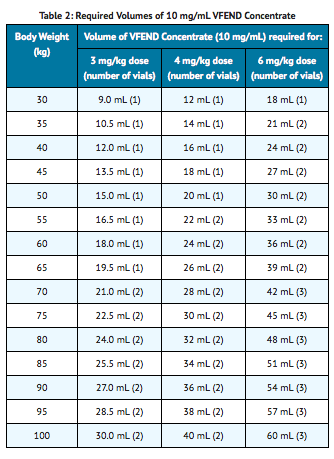
IV Incompatibilities
- Voriconazole I.V. must not be diluted with 4.2% Sodium Bicarbonate Infusion. The mildly alkaline nature of this diluent caused slight degradation of Voriconazole after 24 hours storage at room temperature. Although refrigerated storage is recommended following reconstitution, use of this diluent is not recommended as a precautionary measure.
- Compatibility with other concentrations is unknown.
Overdosage
- In clinical trials, there were three cases of accidental overdose. All occurred in pediatric patients who received up to five times the recommended intravenous dose of voriconazole. A single adverse event of photophobia of 10 minutes duration was reported.
- There is no known antidote to voriconazole.
- Voriconazole is hemodialyzed with clearance of 121 mL/min. The intravenous vehicle, SBECD, is hemodialyzed with clearance of 55 mL/min. In an overdose, hemodialysis may assist in the removal of voriconazole and SBECD from the body.
- The minimum lethal oral dose in mice and rats was 300 mg/kg (equivalent to 4 and 7 times the recommended maintenance dose (RMD), based on body surface area). At this dose, clinical signs observed in both mice and rats included salivation, mydriasis, titubation (loss of balance while moving), depressed behavior, prostration, partially closed eyes, and dyspnea. Other signs in mice were convulsions, corneal opacification and swollen abdomen.
Pharmacology
Mechanism of Action
- Voriconazole is an azole antifungal agent. The primary mode of action of voriconazole is the inhibition of fungal cytochrome P-450-mediated 14 alpha-lanosterol demethylation, an essential step in fungal ergosterol biosynthesis. The accumulation of 14 alpha-methyl sterols correlates with the subsequent loss of ergosterol in the fungal cell wall and may be responsible for the antifungal activity of voriconazole.
Structure
- The structural formula is:
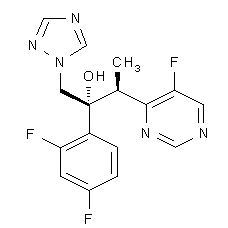
- Voriconazole is designated chemically as (2R,3S)-2-(2, 4-difluorophenyl)-3-(5-fluoro-4-pyrimidinyl)-1-(1H-1,2,4-triazol-1-yl)-2-butanol with an empirical formula of C16H14F3N5O and a molecular weight of 349.3.
Pharmacodynamics
There is limited information regarding Voriconazole (injection) Pharmacodynamics in the drug label.
Pharmacokinetics
The pharmacokinetics of voriconazole have been characterized in healthy subjects, special populations and patients.
- During oral administration of 200 mg or 300 mg twice daily for 14 days in patients at risk of aspergillosis (mainly patients with malignant neoplasms of lymphatic or hematopoietic tissue), the observed pharmacokinetic characteristics were similar to those observed in healthy subjects.
- The pharmacokinetics of voriconazole are non-linear due to saturation of its metabolism. The interindividual variability of voriconazole pharmacokinetics is high. Greater than proportional increase in exposure is observed with increasing dose. It is estimated that, on average, increasing the oral dose from 200 mg q12h to 300 mg q12h leads to an approximately 2.5-fold increase in exposure (AUCτ); similarly, increasing the intravenous dose from 3 mg/kg q12h to 4 mg/kg q12h produces an approximately 2.5-fold increase in exposure (Table 9).
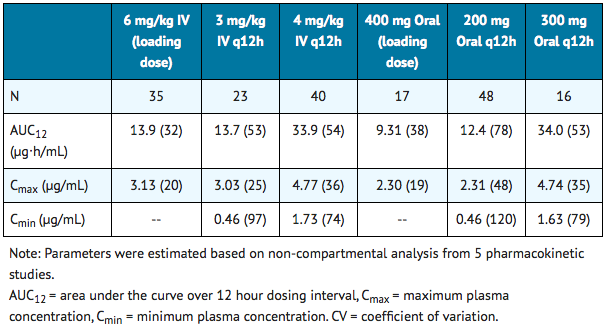
- Sparse plasma sampling for pharmacokinetics was conducted in the therapeutic studies in patients aged 12–18 years. In 11 adolescent patients who received a mean voriconazole maintenance dose of 4 mg/kg IV, the median of the calculated mean plasma concentrations was 1.60 µg/mL (inter-quartile range 0.28 to 2.73 µg/mL). In 17 adolescent patients for whom mean plasma concentrations were calculated following a mean oral maintenance dose of 200 mg q12h, the median of the calculated mean plasma concentrations was 1.16 µg/mL (inter-quartile range 0.85 to 2.14 µg/mL).
- When the recommended intravenous loading dose regimen is administered to healthy subjects, plasma concentrations close to steady state are achieved within the first 24 hours of dosing (eg, 6 mg/kg IV q12h on day 1 followed by 3 mg/kg IV q12h). Without the loading dose, accumulation occurs during twice-daily multiple dosing with steady-state plasma voriconazole concentrations being achieved by day 6 in the majority of subjects.
Absorption
- The pharmacokinetic properties of voriconazole are similar following administration by the intravenous and oral routes. Based on a population pharmacokinetic analysis of pooled data in healthy subjects (N=207), the oral bioavailability of voriconazole is estimated to be 96% (CV 13%). Maximum plasma concentrations (Cmax) are achieved 1–2 hours after dosing. When multiple doses of voriconazole are administered with high-fat meals, the mean Cmax and AUCτ are reduced by 34% and 24%, respectively when administered as a tablet and by 58% and 37% respectively when administered as the oral suspension. In healthy subjects, the absorption of voriconazole is not affected by coadministration of oral ranitidine, cimetidine, or omeprazole, drugs that are known to increase gastric pH.
Distribution
- The volume of distribution at steady state for voriconazole is estimated to be 4.6 L/kg, suggesting extensive distribution into tissues. Plasma protein binding is estimated to be 58% and was shown to be independent of plasma concentrations achieved following single and multiple oral doses of 200 mg or 300 mg (approximate range: 0.9–15 µg/mL). Varying degrees of hepatic and renal insufficiency do not affect the protein binding of voriconazole.
Metabolism
- In vitro studies showed that voriconazole is metabolized by the human hepatic cytochrome P450 enzymes, CYP2C19, CYP2C9 and CYP3A4.
Nonclinical Toxicology
Carcinogenesis, Mutagenesis, Impairment of Fertility
- Two-year carcinogenicity studies were conducted in rats and mice. Rats were given oral doses of 6, 18 or 50 mg/kg voriconazole, or 0.2, 0.6, or 1.6 times the recommended maintenance dose (RMD) on a mg/m2 basis. Hepatocellular adenomas were detected in females at 50 mg/kg and hepatocellular carcinomas were found in males at 6 and 50 mg/kg. Mice were given oral doses of 10, 30 or 100 mg/kg voriconazole, or 0.1, 0.4, or 1.4 times the RMD on a mg/m2 basis. In mice, hepatocellular adenomas were detected in males and females and hepatocellular carcinomas were detected in males at 1.4 times the RMD of voriconazole.
- Voriconazole demonstrated clastogenic activity (mostly chromosome breaks) in human lymphocyte cultures in vitro. Voriconazole was not genotoxic in the Ames assay, CHO assay, the mouse micronucleus assay or the DNA repair test (Unscheduled DNA Synthesis assay).
- Voriconazole administration induced no impairment of male or female fertility in rats dosed at 50 mg/kg, or 1.6 times the RMD (recommended maintenance dose).
Teratogenic Effects
Clinical Studies
Voriconazole, administered orally or parenterally, has been evaluated as primary or salvage therapy in 520 patients aged 12 years and older with infections caused by Aspergillus spp., Fusarium spp., and Scedosporium spp.
Invasive Aspergillosis
- Voriconazole was studied in patients for primary therapy of invasive aspergillosis (randomized, controlled study 307/602), for primary and salvage therapy of aspergillosis (non-comparative study 304) and for treatment of patients with invasive aspergillosis who were refractory to, or intolerant of, other antifungal therapy (non-comparative study 309/604).
Study 307/602 – Primary Therapy of Invasive Aspergillosis
- The efficacy of voriconazole compared to amphotericin B in the primary treatment of acute invasive aspergillosis was demonstrated in 277 patients treated for 12 weeks in a randomized, controlled study (Study 307/602). The majority of study patients had underlying hematologic malignancies, including bone marrow transplantation. The study also included patients with solid organ transplantation, solid tumors, and AIDS. The patients were mainly treated for definite or probable invasive aspergillosis of the lungs. Other aspergillosis infections included disseminated disease, CNS infections and sinus infections. Diagnosis of definite or probable invasive aspergillosis was made according to criteria modified from those established by the National Institute of Allergy and Infectious Diseases Mycoses Study Group/European Organisation for Research and Treatment of Cancer (NIAID MSG/EORTC).
- Voriconazole was administered intravenously with a loading dose of 6 mg/kg every 12 hours for the first 24 hours followed by a maintenance dose of 4 mg/kg every 12 hours for a minimum of seven days. Therapy could then be switched to the oral formulation at a dose of 200 mg q12h. Median duration of IV voriconazole therapy was 10 days (range 2–85 days). After IV voriconazole therapy, the median duration of PO voriconazole therapy was 76 days (range 2–232 days).
- Patients in the comparator group received conventional amphotericin B as a slow infusion at a daily dose of 1.0–1.5 mg/kg/day. Median duration of IV amphotericin therapy was 12 days (range 1–85 days). Treatment was then continued with other licensed antifungal therapy (OLAT), including itraconazole and lipid amphotericin B formulations. Although initial therapy with conventional amphotericin B was to be continued for at least two weeks, actual duration of therapy was at the discretion of the investigator. Patients who discontinued initial randomized therapy due to toxicity or lack of efficacy were eligible to continue in the study with OLAT treatment.
- A satisfactory global response at 12 weeks (complete or partial resolution of all attributable symptoms, signs, radiographic/bronchoscopic abnormalities present at baseline) was seen in 53% of voriconazole treated patients compared to 32% of amphotericin B treated patients (Table 14). A benefit of voriconazole compared to amphotericin B on patient survival at Day 84 was seen with a 71% survival rate on voriconazole compared to 58% on amphotericin B (Table 12).
Table 12 also summarizes the response (success) based on mycological confirmation and species.
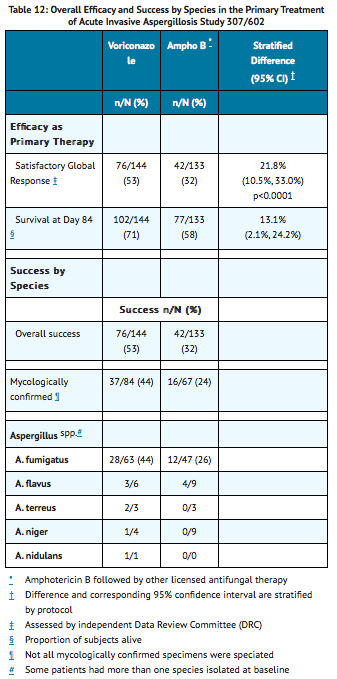
Study 304 – Primary and Salvage Therapy of Aspergillosis
- In this non-comparative study, an overall success rate of 52% (26/50) was seen in patients treated with voriconazole for primary therapy. Success was seen in 17/29 (59%) with Aspergillus fumigatus infections and 3/6 (50%) patients with infections due to non-fumigatus species [A. flavus (1/1); A. nidulans (0/2); A. niger (2/2); A. terreus (0/1)]. Success in patients who received voriconazole as salvage therapy is presented in Table 13.
Study 309/604 – Treatment of Patients with Invasive Aspergillosis who were Refractory to, or Intolerant of, other Antifungal Therapy
- Additional data regarding response rates in patients who were refractory to, or intolerant of, other antifungal agents are also provided in Table 15. In this non-comparative study, overall mycological eradication for culture-documented infections due to fumigatus and non-fumigatus species of Aspergillus was 36/82 (44%) and 12/30 (40%), respectively, in voriconazole treated patients. Patients had various underlying diseases and species other than A. fumigatus contributed to mixed infections in some cases.
- For patients who were infected with a single pathogen and were refractory to, or intolerant of, other antifungal agents, the satisfactory response rates for voriconazole in studies 304 and 309/604 are presented in Table 13.
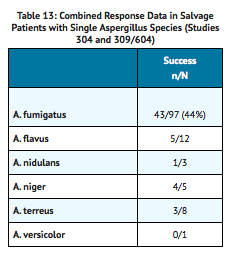
Candidemia in Non-neutropenic Patients and Other Deep Tissue Candida Infections
- Voriconazole was compared to the regimen of amphotericin B followed by fluconazole in Study 608, an open label, comparative study in nonneutropenic patients with candidemia associated with clinical signs of infection. Patients were randomized in 2:1 ratio to receive either voriconazole (n=283) or the regimen of amphotericin B followed by fluconazole (n=139). Patients were treated with randomized study drug for a median of 15 days. Most of the candidemia in patients evaluated for efficacy was caused by C. albicans (46%), followed by C. tropicalis (19%), C. parapsilosis (17%), C. glabrata (15%), and C. krusei (1%).
- An independent Data Review Committee (DRC), blinded to study treatment, reviewed the clinical and mycological data from this study, and generated one assessment of response for each patient. A successful response required all of the following: resolution or improvement in all clinical signs and symptoms of infection, blood cultures negative for Candida, infected deep tissue sites negative for Candida or resolution of all local signs of infection, and no systemic antifungal therapy other than study drug. The primary analysis, which counted DRC-assessed successes at the fixed time point (12 weeks after End of Therapy [EOT]), demonstrated that voriconazole was comparable to the regimen of amphotericin B followed by fluconazole (response rates of 41% and 41%, respectively) in the treatment of candidemia. Patients who did not have a 12-week assessment for any reason were considered a treatment failure.
- The overall clinical and mycological success rates by Candida species in Study 150-608 are presented in Table 14.
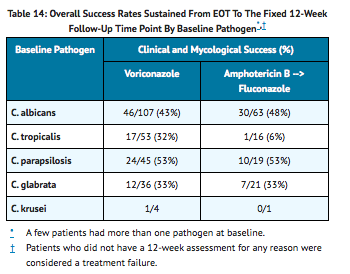
- In a secondary analysis, which counted DRC-assessed successes at any time point (EOT, or 2, 6, or 12 weeks after EOT), the response rates were 65% for voriconazole and 71% for the regimen of amphotericin B followed by fluconazole.
- In Studies 608 and 309/604 (non-comparative study in patients with invasive fungal infections who were refractory to, or intolerant of, other antifungal agents), voriconazole was evaluated in 35 patients with deep tissue Candida infections. A favorable response was seen in 4 of 7 patients with intra-abdominal infections, 5 of 6 patients with kidney and bladder wall infections, 3 of 3 patients with deep tissue abscess or wound infection, 1 of 2 patients with pneumonia/pleural space infections, 2 of 4 patients with skin lesions, 1 of 1 patients with mixed intraabdominal and pulmonary infection, 1 of 2 patients with suppurative phlebitis, 1 of 3 patients with hepatosplenic infection, 1 of 5 patients with osteomyelitis, 0 of 1 with liver infection, and 0 of 1 with cervical lymph node infection.
Esophageal Candidiasis
- The efficacy of oral voriconazole 200 mg twice daily compared to oral fluconazole 200 mg once daily in the primary treatment of esophageal candidiasis was demonstrated in Study 150-305, a double-blind, double-dummy study in immunocompromised patients with endoscopically-proven esophageal candidiasis. Patients were treated for a median of 15 days (range 1 to 49 days). Outcome was assessed by repeat endoscopy at end of treatment (EOT). A successful response was defined as a normal endoscopy at EOT or at least a 1 grade improvement over baseline endoscopic score. For patients in the Intent to Treat (ITT) population with only a baseline endoscopy, a successful response was defined as symptomatic cure or improvement at EOT compared to baseline. Voriconazole and fluconazole (200 mg once daily) showed comparable efficacy rates against esophageal candidiasis, as presented in Table 15.
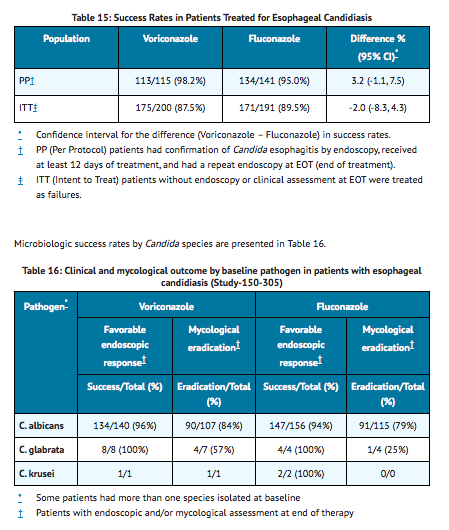
Other Serious Fungal Pathogens
'In pooled analyses of patients, voriconazole was shown to be effective against the following additional fungal pathogens:
- Scedosporium apiospermum - Successful response to voriconazole therapy was seen in 15 of 24 patients (63%). Three of these patients relapsed within 4 weeks, including 1 patient with pulmonary, skin and eye infections, 1 patient with cerebral disease, and 1 patient with skin infection. Ten patients had evidence of cerebral disease and 6 of these had a successful outcome (1 relapse). In addition, a successful response was seen in 1 of 3 patients with mixed organism infections.
- Fusarium spp. - Nine of 21 (43%) patients were successfully treated with voriconazole. Of these 9 patients, 3 had eye infections, 1 had an eye and blood infection, 1 had a skin infection, 1 had a blood infection alone, 2 had sinus infections, and 1 had disseminated infection (pulmonary, skin, hepatosplenic). Three of these patients (1 with disseminated disease, 1 with an eye infection and 1 with a blood infection) had Fusarium solani and were complete successes. Two of these patients relapsed, 1 with a sinus infection and profound neutropenia and 1 post surgical patient with blood and eye infections.
How Supplied
Powder for Solution for Injection
- Voriconazole I.V. for Injection is supplied in a single use vial as a sterile lyophilized powder equivalent to 200 mg Voriconazole and 3200 mg sulfobutyl ether beta-cyclodextrin sodium (SBECD).
- Individually packaged vials of 200 mg Voriconazole I.V: (NDC 0049-3190-38)
Storage
- Voriconazole I.V. for Injection unreconstituted vials should be stored at 15° – 30°C (59° – 86°F) [see USP Controlled Room Temperature]. Voriconazole is a single dose unpreserved sterile lyophile. From a microbiological point of view, following reconstitution of the lyophile with Water for Injection, the reconstituted solution should be used immediately. If not used immediately, in-use storage times and conditions prior to use are the responsibility of the user and should not be longer than 24 hours at 2° to 8°C (36° to 46°F). Chemical and physical in-use stability has been demonstrated for 24 hours at 2° to 8°C (36° to 46°F). This medicinal product is for single use only and any unused solution should be discarded. Only clear solutions without particles should be used
Images
Drug Images
{{#ask: Page Name::Voriconazole (injection) |?Pill Name |?Drug Name |?Pill Ingred |?Pill Imprint |?Pill Dosage |?Pill Color |?Pill Shape |?Pill Size (mm) |?Pill Scoring |?NDC |?Drug Author |format=template |template=DrugPageImages |mainlabel=- |sort=Pill Name }}
Package and Label Display Panel
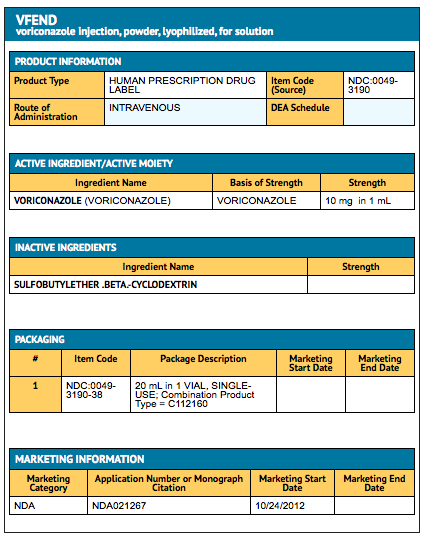
{{#ask: Label Page::Voriconazole (injection) |?Label Name |format=template |template=DrugLabelImages |mainlabel=- |sort=Label Page }}
Patient Counseling Information
There is limited information regarding Voriconazole (injection) Patient Counseling Information in the drug label.
Precautions with Alcohol
- Alcohol-Voriconazole interaction has not been established. Talk to your doctor about the effects of taking alcohol with this medication.
Brand Names
- Voriconazole
- Voriconazole I.V.
Look-Alike Drug Names
There is limited information regarding Voriconazole (injection) Look-Alike Drug Names in the drug label.
Drug Shortage Status
Price
References
The contents of this FDA label are provided by the National Library of Medicine.
{{#subobject:
|Label Page=Voriconazole (injection) |Label Name=Voriconazole Package.png
}}